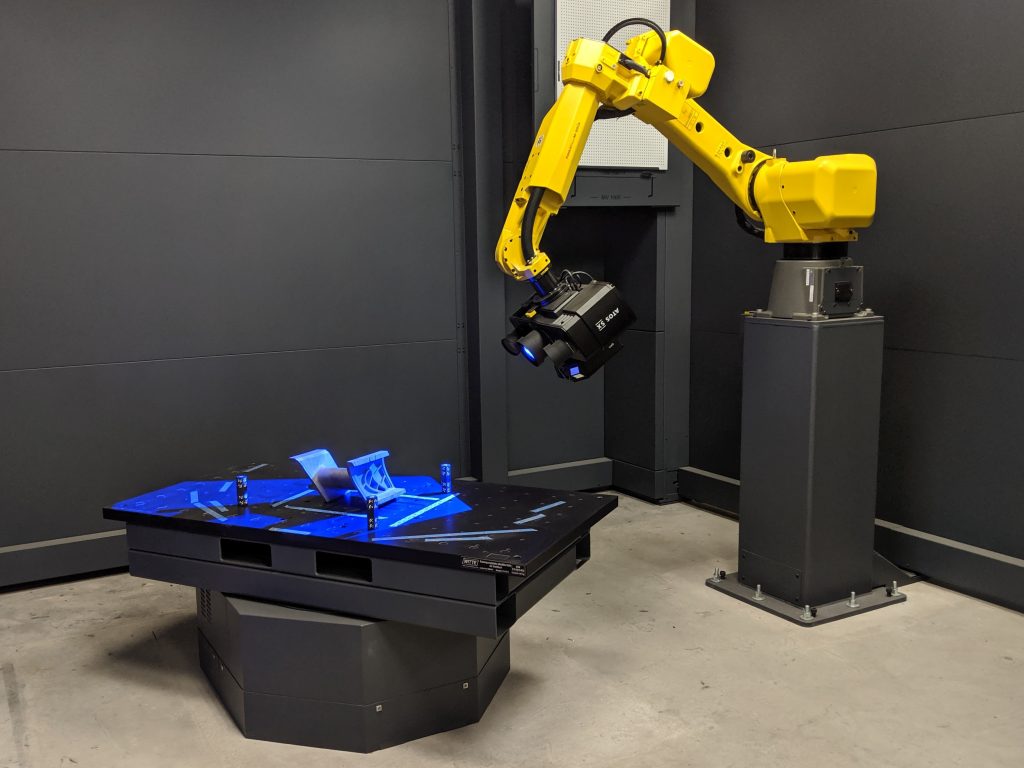Siemens officially opened the doors to its Innovation Center in Orlando early last week. The 17,000 square foot facility was conceived as a collaboration between Siemens Gas and Power and Materials Solutions, the UK-based metal additive manufacturing business Siemens acquired in 2016. 3D Printing Industry attended the opening event to learn more about the center’s commitment to rapid problem solving for internal and external customers alike.
Co-location breeds innovation
Co-locating interdisciplinary designers and engineers with the various additive manufacturing, inspection, CNC machining, and robotics capabilities alongside Materials Solutions’ metal AM expertise is a recipe for rapid innovation. Vinod Philip, CEO of Siemens Service Power Generation, highlighted that the “center is designed to bring disciplines, backgrounds, and functions together to co-create in partnership with customers, partners, and suppliers.” Representatives from numerous aerospace, gas, and power companies were present for the facility tour that started with the new EOS M400-4 3D printer intended for titanium part production.

As the U.S. manufacturing presence for Materials Solutions, the innovation center will serve external customers in aerospace and other high-performance industries with EOS M400-4 and EOS M290 systems within an ITAR-controlled environment, according to Markus Seibold, VP of Additive Manufacturing at Siemens Power Generation Operations. With expansion plans for a third system already in the works, the tour moved onto the various inspection and machining capabilities that support laser powder bed part production.
Integrated inspection and verification
A GOM Capture 3D system serves the center to 3D scan large parts for dimensional verification as well as reverse engineering purposes.

Other equipment on-site includes two Fanuc robotic arms for milling, grinding, and pick & place operations, a Siemens X-ray CT scanner, nine Markforged material extrusion printers, and a machine shop with various 3/5-axis CNC machining and wire electric discharge manufacturing (EDM) equipment.

The 30+ interdisciplinary designers and engineers work at the Innovation Center developing tools, components, and patentable ideas. Both Siemens Gas and Power and Materials Solutions benefit from the rapid prototyping process, often providing entirely custom solutions to problems in the field.
The innovation potential Siemens expects from such a center is already being realized in the field with a custom-built fully autonomous inspection drone. The drone collects optical pictures and thermal maps of powerplants that are rendered into a 3D model for experts to remotely inspect problem areas. The resulting recommendations could relate to hot spots indicating inefficiencies in the plant, concerns around corroded structures, or simply to reduce the frequency of manual inspections.

Benefiting new and existing equipment
Speaking with Markus Seibold further on the vision for Materials Solutions in the U.S. as part of this Innovation Center, he highlighted multiple high-value components for industrial gas turbines that have already benefited from the collaborations with the Gas and Power division. One combustion part in particular for the 8000H engines was redesigned for additive to consolidate twelve parts into one, and having been successfully qualified, is now in serial production on the order of 1000s of parts a year. With the new center in the U.S., Materials Solutions brings 12+ years of metal additive manufacturing expertise to local markets and is expanding its offering with design and training services to compliment the part production, certification, and qualification the company is known for. Markus concluded that Materials Solutions has a unique OEM-level understanding thanks to the close collaboration with Siemens Gas & Power and with a U.S. presence, is now positioned to satisfy both the technical demands and supply chain requirements in the energy, aerospace and other high-performance industries.
With many looking to metal 3D printing as a growth leader for the 3D printing industry, Materials Solutions and Siemens are taking important steps to ensure existing as well as prospective customers that they are open for business as a multinational solutions and services provider.
For 3D Printing Industry’s coverage of all the latest events and product releases subscribe to our newsletter, like us on Facebook and follow us on Twitter. Seeking a career move? Visit 3D Printing Jobs.
Featured image shows Quan Lac, Head of Additive Manufacturing Americas for Siemens Gas & Power, giving an overview of Materials Solutions’ U.S.-based EOS M400-4. Photo by Dayton Horvath for 3D Printing Industry



